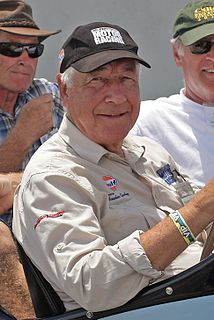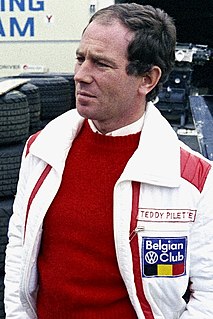McLaren Racing Limited is a British motor racing team based at the McLaren Technology Centre in Woking, Surrey, England. McLaren is best known as a Formula One constructor, the second oldest active team, and the second most successful Formula One team after Ferrari, having won 183 races, 12 Drivers' Championships and 8 Constructors' Championships. McLaren also has a history of competing in American open wheel racing, as both an entrant and a chassis constructor, and has won the Canadian-American Challenge Cup (Can-Am) sports car racing championship. The team is a subsidiary of the McLaren Group, which owns a majority of the team.
Lola Cars International Ltd. was a British race car engineering company in operation from 1958 to 2012. The company was founded by Eric Broadley in Bromley, England, before moving to new premises in Slough, Buckinghamshire and finally Huntingdon, Cambridgeshire, and endured for more than fifty years to become one of the oldest and largest manufacturers of racing cars in the world. Lola Cars started by building small front-engined sports cars, and branched out into Formula Junior cars before diversifying into a wider range of sporting vehicles. Lola was acquired by Martin Birrane in 1998 after the unsuccessful MasterCard Lola attempt at Formula One.

James Howden Ganley is a former racing driver from New Zealand. From 1971 to 1974 he participated in 41 World Championship Formula One Grands Prix. He placed 4th twice and scored points 5 times for a total of 10 championship points. He also participated in numerous non-Championship Formula One races.

Peter Kenneth Gethin was a British racing driver from England. He participated in 31 World Championship Formula One Grands Prix, debuting on 21 June 1970. He won the 1971 Italian Grand Prix in the fastest average speed in Formula One history, but this was his only podium finish. Gethin also participated in numerous non-Championship Formula One races, winning the 1971 World Championship Victory Race and the 1973 Race of Champions.

Theodore "Teddy" Pilette is a former racing driver from Belgium. He participated in 4 Formula One World Championship Grands Prix, the first on 12 May 1974 with Bernie Ecclestone's Brabham team.
Theodore Racing (徳利賽車隊香港) was a Formula One constructor from Hong Kong founded by real estate magnate and millionaire Teddy Yip. They participated in 51 grands prix, entering a total of 64 cars.

Formula 5000 was an open wheel, single seater auto-racing formula that ran in different series in various regions around the world from 1968 to 1982. It was originally intended as a low-cost series aimed at open-wheel racing cars that no longer fit into any particular formula. The '5000' denomination comes from the maximum 5.0 litre engine capacity allowed in the cars, although many cars ran with smaller engines. Manufacturers included McLaren, Eagle, March, Lola, Lotus, Elfin, Matich and Chevron.

Colin John Bond is a retired Australian racing driver. Bond reached the highest levels in Australian motorsport in 1969 when he was recruited by Harry Firth to the newly formed Holden Dealer Team. He quickly found success, winning the 1969 Hardie-Ferodo 500 mile race at Bathurst, New South Wales in a Holden Monaro.

Oulton Park is a hard surfaced track used for motor racing, close to the village of Little Budworth, Cheshire, England. It is about 5 mi (8.0 km) from Winsford, 13 mi (21 km) from Chester city centre, 8 mi (13 km) from Northwich and 17 mi (27 km) from Warrington, with a nearby rail connection along the Mid-Cheshire Line. It occupies much of the area which was previously known as the Oulton Estate. The racing circuit is owned and operated by Jonathan Palmer's MotorSport Vision organisation.
The 1974 Tasman Series was an international motor racing competition which commenced on 5 January and ended on 23 February 1974 after eight races. The championship, which was the eleventh Tasman Championship, was open to Racing cars complying with the Tasman Formula. The winner was awarded the Tasman Cup.

The Lola T332 was a race car designed and built by Lola Cars for use in Formula 5000 racing and made its racing debut in 1973. The T332 was successful around the globe with race victories in places such as Australia, the United Kingdom, New Zealand and the United States. The Lola commonly used the 5.0-litre Chevrolet V8 engine, though some competitors in Australia and New Zealand used the slightly cheaper and less powerful Australian made 5.0-litre Repco Holden V8.

The 19th International Gold Cup was a non-championship Formula One race, which was held on the Oulton Park circuit, located near Tarporley, Cheshire, England on 29 May 1972.
The 1973 Rothmans 5000 European Championship was a motor racing series for Formula 5000 cars. The series was organized in the United Kingdom by the British Racing and Sports Car Club but also incorporated European rounds. It was the fifth in an annual sequence of European Formula 5000 Championships, and the first to be contested as the Rothmans 5000 European Championship. The 1973 championship was won by Teddy Pilette, driving a McLaren M18 and a Chevron B24.
The 1975 ShellSPORT 5000 European Championship was a motor racing series for Formula 5000 cars. The series was organized in the United Kingdom by the British Racing and Sports Car Club, but also incorporated European rounds. It was the seventh and last in a sequence of annual European Formula 5000 Championships, and the first to be contested as the ShellSPORT 5000 European Championship. The 1975 championship was won by Teddy Pilette, driving a Lola T400.
The Chevron B30 is an open-wheel race car, designed, developed and built by British manufacturer and constructor, Chevron, for Formula 5000 racing, in 1975, where it found modest success. It was driven by Briton David Purley. Purley won 2 races in the 1975 Championship season, eventually finishing the championship in 5th-place, with 98 points. It was powered by a Cosworth-tuned naturally-aspirated 3.4 L (210 cu in) Ford V6 engine, and was the only car on the grid to be fielding a V6 engine. It was also entered into one non-championship Formula One race, the Race of Champions at Brands Hatch, but failed to qualify. It was later converted into a Group 8 car, where it competed in the short-lived Shellsport International Formula Libre racing series. David Purley successfully won the 1976 Championship season, winning 6 out of the 13 races that season, taking 7 podium finishes, as well as 4 pole positions, and 7 fastest laps, and finishing the season with 188 championship points.

The Brabham BT43 was the only Formula 5000 racing car built by Motor Racing Developments (MRD). Initiated by Ron Tauranac, designed by Geoff Ferris, and built by a team including Nick Goozee (monocoque) and Bob Paton (construction), it was one of the last cars produced by MRD before MRD was closed by the then new Brabham owner Bernie Ecclestone. Based on the Formula Two Brabham BT40 the BT43 featured a modified monocoque that incorporated the triangular cross section pioneered by the Brabham BT42 Formula One car which was designed by Gordon Murray. This distinctive pyramid shape not only kept the aerodynamic "stagnation point" low but also neatly allowed the incorporation of a "crushable structure" as required by the 1973 regulations which specified that all fuel tanks were to be protected by deformable structures. Engine and gearbox were the then de facto F5000 standard combination of a Chevrolet 302 cubic inch engine in an unstressed mounting and a Hewland DG300 gearbox. The fitment of these into what was a relatively small Formula Two sized car presented some design challenges. Front suspension components were BT40 while rear suspension components were a combination of Formula One and BT40.
Anthony Gordon Dean was a British racing driver from England who competed in sports car racing, touring car racing, the Can-Am series and various single seat formulae, including non-championship Formula One, in the 1960s, 1970s, and 1980s. He is known for winning a round of the Can-Am championship in 1970 as a privateer entrant.
Keith Holland is a British former racing driver from England who competed in various classes of racing in the 1960s and 1970s. He is known for winning the 1969 Madrid Grand Prix in a Formula 5000 car in a field which contained several Formula One entries. He was also a regular competitor in the British Formula 5000 Championship finishing third in the title standings on two occasions.

The Brabham BT30 was a open-wheel Formula 2 racing car used in the 1969, 1970, and 1971 European Formula Two Championship.

The Chevron B24 was a Formula 5000 racing car developed by Chevron Cars in 1972.











